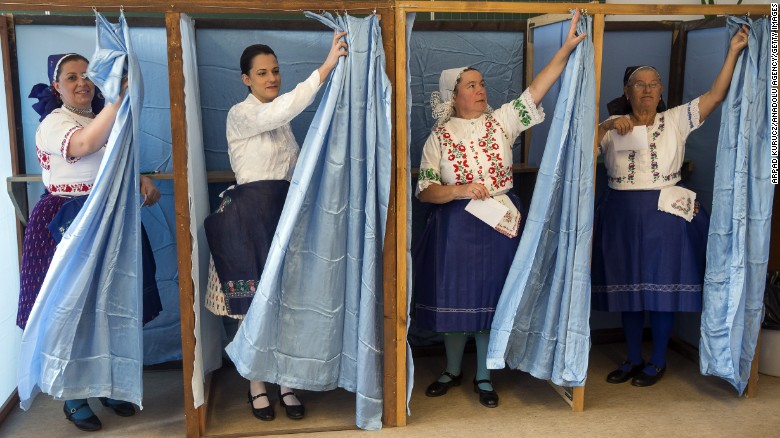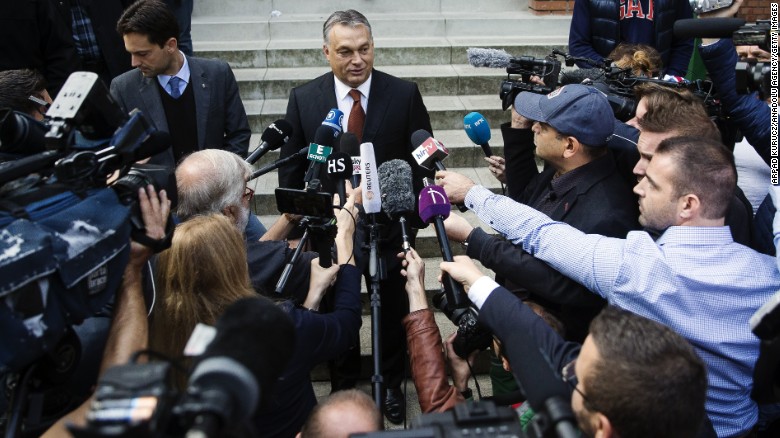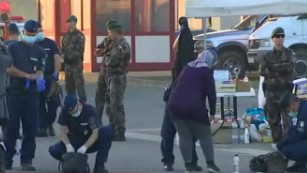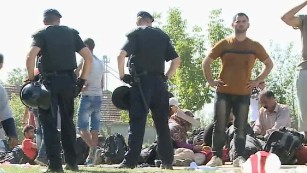Hungary voters reject EU migrant-resettlement plan, but low turnout invalidates results
Hungarians voted Sunday to reject a European Union refugee resettlement plan, but failed to turn out in sufficient numbers to make the referendum legally binding.
Voter turnout was 43.7%, according to data published on the Hungarian National Election Office website, short of the 50% participation required to make the referendum valid under Hungarian law.
Gulyás Gergely, the Vice-President of Hungary's ruling party, FIDESZ, nevertheless described the result as an "overwhelming victory" that demonstrated "unprecedented unity." He said that more than 90% of those who did vote supported Prime Minister Viktor Orban's "No" position.

Hungarian women wearing traditional clothes cast their ballot at a polling station Sunday in Budapest.
In a Sunday evening television address, Orban said the European Union cannot force migration policies on Hungary and vowed to fight any efforts to do so.
"Can a democratic community [the EU] force its will to a member where 92% [of the voters] is against it? I promise, I will do everything so this can never ever happen," he said.
Orban had spearheaded a campaign asking Hungarians to reject EU migrant quotas for the country. Before the referendum, advertisements blanketed airwaves painting migrants in a negative light. Leaflets distributed throughout the country, along with posters and billboards, warned of the dangers of accepting refugees.
"We lose our European values and identity the way frogs are cooked in slowly heating water," Orban said Friday. "Quite simply, slowly there will be more and more Muslims, and we will no longer recognize Europe."

Hungarian Prime Minister Viktor Orban speaks to media after casting his vote.
"What we have seen so far from the people's migration have only been warmup rounds. The real battle is yet to come," he added.
Opinion: Hungary's treatment of refugees is a disgrace to its history
Under the agreement with the European Union reached last fall, Hungary would have to accept 1,294 refugees.

Migrants pass through Croatia to Hungary
"This is a piece of international PR," said John Dalhuisen, the Europe director for Amnesty International. "This is international marketing. He's selling himself as the ideologue of a radically different migration policy. You'd characterize (German Chancellor Angela) Merkel as being 'let them come' -- he's saying the solution to the refugee crisis, to the migration issues in Europe, is 'let no one come.'"

Migrants find confusion at European borders
Last year, when a mass exodus of migrants from Syria, Iraq and other countries flooded the Hungarian border, strict measures like razor wire fences and "border hunters" were put in place.
In footage that went viral, a Hungarian camerawoman was seen tripping refugees making a run for the border.

Hungary mayor's anti-migrants video
Hungarian riot police used tear gas and water cannons at the country's border with Serbia last year after a group of migrants attempting to enter the European Union broke through a barrier.
Hungary has recently erected a razor-wire fence that runs the entire length of the country's borders with Serbia and Croatia.
Migrants from the Middle East and southeast Asia often cross the Mediterranean and try to go through Greece, Macedonia, Serbia, Hungary and Austria in an attempt to reach Germany or other European countries known to be more welcoming to refugees.
News Courtesy: www.cnn.com











